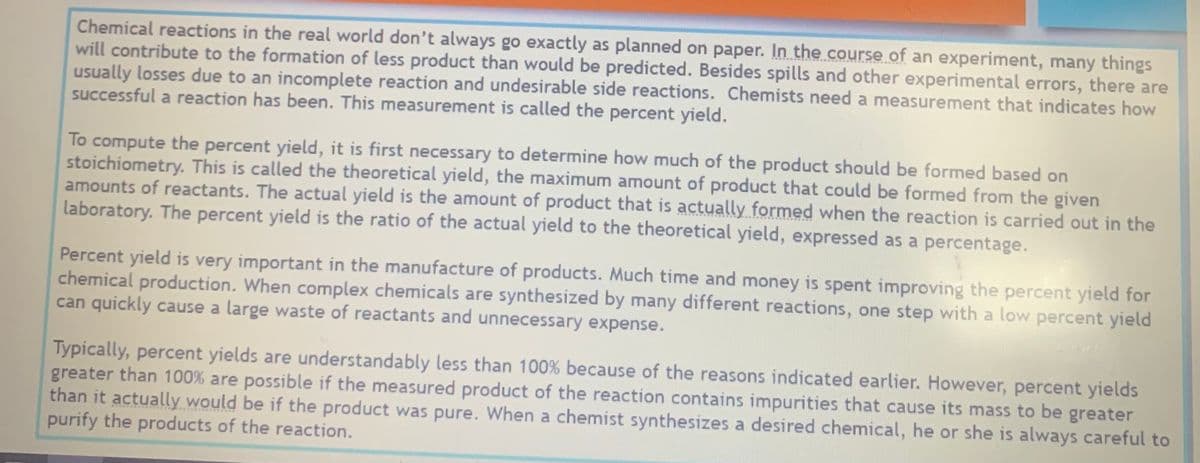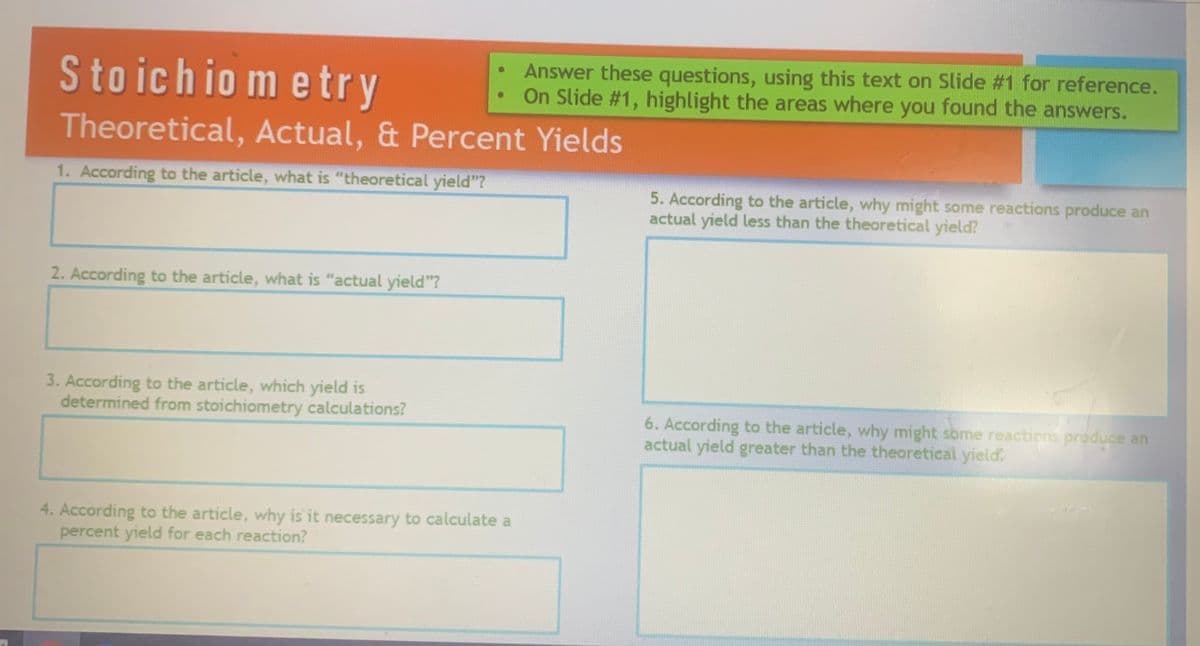Theoretical, Actual, & Percent Yields 1. According to the article, what is "theoretical yield"? 2. According to the article, what is "actual yield"? 3. According to the article, which yield is determined from stoichiometry calculations? OR Slide #1, highlight the areas where you found the answers. 4. According to the article, why is it necessary to calculate a percent yield for each reaction? 5. According to the article, why might some reactions produce an actual yield less than the theoretical yield? 6. According to the article, why might some reactions produce an actual yield greater than the theoretical yield.
Theoretical, Actual, & Percent Yields 1. According to the article, what is "theoretical yield"? 2. According to the article, what is "actual yield"? 3. According to the article, which yield is determined from stoichiometry calculations? OR Slide #1, highlight the areas where you found the answers. 4. According to the article, why is it necessary to calculate a percent yield for each reaction? 5. According to the article, why might some reactions produce an actual yield less than the theoretical yield? 6. According to the article, why might some reactions produce an actual yield greater than the theoretical yield.
Chemistry: The Molecular Science
5th Edition
ISBN:9781285199047
Author:John W. Moore, Conrad L. Stanitski
Publisher:John W. Moore, Conrad L. Stanitski
Chapter3: Chemical Reactions
Section: Chapter Questions
Problem 141QRT
Related questions
Question
100%

Transcribed Image Text:Chemical reactions in the real world don't always go exactly as planned on paper. In the course of an experiment, many things
will contribute to the formation of less product than would be predicted. Besides spills and other experimental errors, there are
usually losses due to an incomplete reaction and undesirable side reactions. Chemists need a measurement that indicates how
successful a reaction has been. This measurement is called the percent yield.
To compute the percent yield, it is first necessary to determine how much of the product should be formed based on
stoichiometry. This is called the theoretical yield, the maximum amount of product that could be formed from the given
amounts of reactants. The actual yield is the amount of product that is actually formed when the reaction is carried out in the
laboratory. The percent yield is the ratio of the actual yield to the theoretical yield, expressed as a percentage.
Percent yield is very important in the manufacture of products. Much time and money is spent improving the percent yield for
chemical production. When complex chemicals are synthesized by many different reactions, one step with a low percent yield
can quickly cause a large waste of reactants and unnecessary expense.
Typically, percent yields are understandably less than 100 % because of the reasons indicated earlier. However, percent yields
greater than 100% are possible if the measured product of the reaction contains impurities that cause its mass to be greater
than it actually would be if the product was pure. When a chemist synthesizes a desired chemical, he or she is always careful to
purify the products of the reaction.

Transcribed Image Text:Stoichiometry
Theoretical, Actual, & Percent Yields
1. According to the article, what is "theoretical yield"?
2. According to the article, what is "actual yield"?
3. According to the article, which yield is
determined from stoichiometry calculations?
●
4. According to the article, why is it necessary to calculate a
percent yield for each reaction?
Answer these questions, using this text on Slide #1 for reference.
On Slide #1, highlight the areas where you found the answers.
5. According to the article, why might some reactions produce an
actual yield less than the theoretical yield?
6. According to the article, why might some reactions produce an
actual yield greater than the theoretical yield?
Expert Solution
This question has been solved!
Explore an expertly crafted, step-by-step solution for a thorough understanding of key concepts.
This is a popular solution!
Trending now
This is a popular solution!
Step by step
Solved in 5 steps

Knowledge Booster
Learn more about
Need a deep-dive on the concept behind this application? Look no further. Learn more about this topic, chemistry and related others by exploring similar questions and additional content below.Recommended textbooks for you

Chemistry: The Molecular Science
Chemistry
ISBN:
9781285199047
Author:
John W. Moore, Conrad L. Stanitski
Publisher:
Cengage Learning

World of Chemistry, 3rd edition
Chemistry
ISBN:
9781133109655
Author:
Steven S. Zumdahl, Susan L. Zumdahl, Donald J. DeCoste
Publisher:
Brooks / Cole / Cengage Learning

Introductory Chemistry: A Foundation
Chemistry
ISBN:
9781337399425
Author:
Steven S. Zumdahl, Donald J. DeCoste
Publisher:
Cengage Learning

Chemistry: The Molecular Science
Chemistry
ISBN:
9781285199047
Author:
John W. Moore, Conrad L. Stanitski
Publisher:
Cengage Learning

World of Chemistry, 3rd edition
Chemistry
ISBN:
9781133109655
Author:
Steven S. Zumdahl, Susan L. Zumdahl, Donald J. DeCoste
Publisher:
Brooks / Cole / Cengage Learning

Introductory Chemistry: A Foundation
Chemistry
ISBN:
9781337399425
Author:
Steven S. Zumdahl, Donald J. DeCoste
Publisher:
Cengage Learning

Chemistry for Engineering Students
Chemistry
ISBN:
9781285199023
Author:
Lawrence S. Brown, Tom Holme
Publisher:
Cengage Learning

Chemistry for Engineering Students
Chemistry
ISBN:
9781337398909
Author:
Lawrence S. Brown, Tom Holme
Publisher:
Cengage Learning

Living By Chemistry: First Edition Textbook
Chemistry
ISBN:
9781559539418
Author:
Angelica Stacy
Publisher:
MAC HIGHER